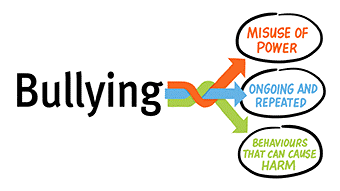What is bullying?
Bullying can happen at school, at home or online. It is never okay and it is not a normal part of growing up.
There is a new nationally agreed definition of bullying which all Australian schools now use:
Bullying is an ongoing and deliberate misuse of power in relationships through repeated verbal, physical and/or social behaviour that intends to cause physical, social and/or psychological harm. It can involve an individual or a group misusing their power, or perceived power, over one or more persons who feel unable to stop it from happening.
Bullying can happen in person or online, via various digital platforms and devices and it can be obvious (overt) or hidden (covert). Bullying behaviour is repeated, or has the potential to be repeated, over time (for example, through sharing of digital records).
Bullying of any form or for any reason can have immediate, medium and long-term effects on those involved, including bystanders. Single incidents and conflict or fights between equals, whether in person or online, are not defined as bullying.

The 3 main features of bullying are:
- the misuse of power in a relationship
- it is ongoing and repeated
- it involves behaviours that can cause harm.
What is not bullying?
There are also some behaviours, which, although they might be unpleasant or distressing, are not bullying:
- mutual conflict that involves a disagreement, but not an imbalance of power. Unresolved mutual conflict can develop into bullying if one of the parties targets the other repeatedly in retaliation
- single-episode acts of nastiness or physical aggression, or aggression directed towards many different people, is not bullying
- social rejection or dislike is not bullying unless it involves deliberate and repeated attempts to cause distress, exclude or create dislike by others.
Information and advice
https://www.vic.gov.au/bullying-information-parents





